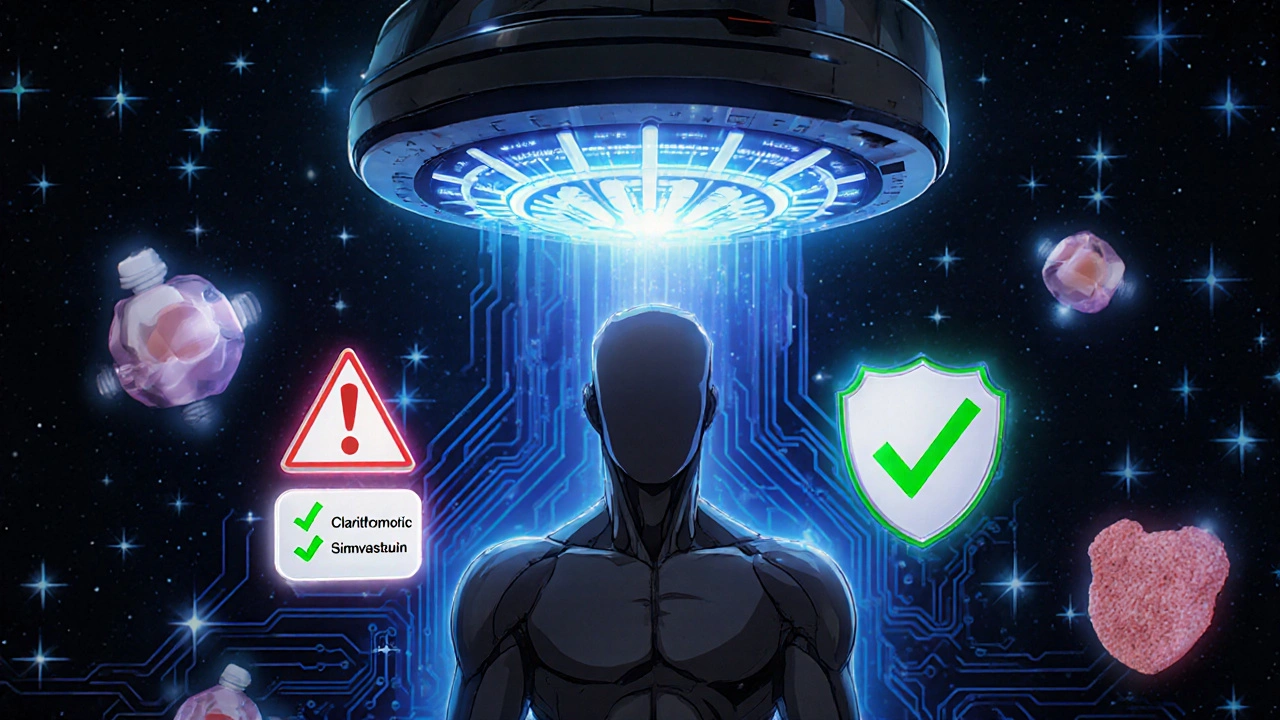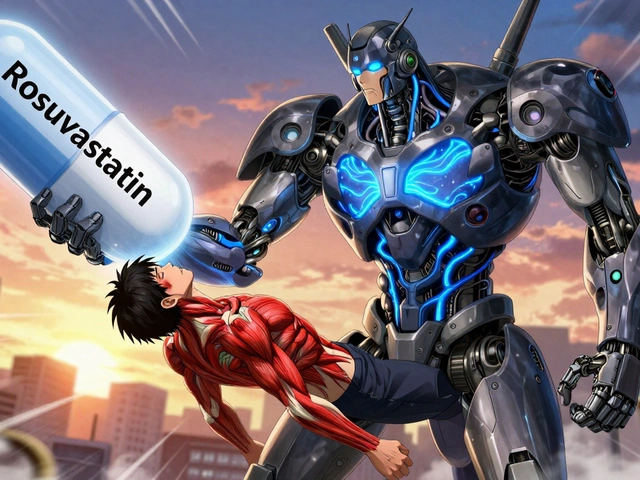When you’re on a statin to lower your cholesterol and then get sick with a sinus infection or pneumonia, your doctor might reach for clarithromycin. It’s a common antibiotic. But here’s the problem: clarithromycin can turn your statin into a ticking time bomb for your muscles.
You might feel fine at first. Then, out of nowhere, your legs ache. Your shoulders feel like they’re full of lead. Maybe you notice dark urine. If you’re taking simvastatin or lovastatin with clarithromycin, you’re at real risk of rhabdomyolysis - a rare but deadly condition where muscle tissue breaks down, flooding your bloodstream with toxins that can wreck your kidneys. This isn’t a theory. It’s a documented danger, with over 120 cases reported to the FDA between 2004 and 2013 alone.
Why This Interaction Happens
Clarithromycin doesn’t just kill bacteria - it also shuts down a key liver enzyme called CYP3A4. This enzyme is responsible for breaking down several statins. When it’s blocked, those statins pile up in your blood. Think of it like a clogged drain: the water (statin) keeps flowing in, but nothing can escape. For simvastatin, levels can spike 10 to 12 times higher than normal. Lovastatin? Up to 20 times. Atorvastatin jumps 4 to 8 times. That’s not a small increase. That’s enough to push you past the safety threshold.
And here’s what makes it worse: clarithromycin’s effects don’t vanish when you stop taking it. Its active metabolite sticks around for up to 10 days. So even if you finish your antibiotic course, your statin is still being overprocessed for days afterward. That’s why some people don’t feel symptoms until a week after they’ve stopped clarithromycin.
Which Statins Are Most Dangerous?
Not all statins are created equal when it comes to this interaction. Some are far riskier than others.
- Simvastatin - Highest risk. The FDA says never take more than 20 mg daily with clarithromycin. At 40 mg or higher, the risk of muscle damage jumps dramatically. Many ER cases come from patients on 40 mg or 80 mg simvastatin who got clarithromycin without knowing the danger.
- Lovastatin - Almost as bad. The EMA recommends avoiding it entirely with clarithromycin.
- Atorvastatin - Moderate risk. Keep the dose at or below 20 mg during clarithromycin treatment. Higher doses still carry danger.
- Rosuvastatin - Lower risk. It’s mostly cleared by the kidneys, not the liver. Still, don’t go above 20 mg daily while on clarithromycin.
- Pravastatin and Fluvastatin - Safest options. They don’t rely much on CYP3A4. No dose change needed.
There’s a reason some doctors now avoid prescribing simvastatin altogether. It’s not just about this one interaction. It’s about how easily it can go wrong - and how hard it is to catch early.
Real Cases, Real Consequences
JohnDoe78 on Drugs.com described his experience: 40 mg of simvastatin, a course of clarithromycin, and then sudden, unbearable muscle pain. His creatine kinase (CK) levels hit 12,500 U/L - normal is under 200. He ended up in the ER. Another Reddit user, CardioPatient, shared how switching from clarithromycin to azithromycin saved them from muscle pain while on atorvastatin.
A 2019 case series in the AGE Bulletin documented patients with CK levels as high as 213,978 U/L - that’s over 1,000 times the normal range. These patients didn’t just have sore muscles. They needed morphine for pain. Some developed kidney failure. One woman was hospitalized for over two weeks.
And it’s not just older people. A 2021 study found symptoms started as early as day one after starting clarithromycin, with an average onset of 3.2 days. That means the damage can happen fast - before you even realize something’s wrong.

What You Should Do Instead
You don’t have to choose between treating your infection and protecting your muscles. There are safer paths.
- Switch antibiotics. Azithromycin (Zithromax) is the gold standard alternative. It doesn’t block CYP3A4. A 2013 study in the Canadian Medical Association Journal found that people on azithromycin and statins had no increased risk of rhabdomyolysis. The risk of hospitalization for muscle damage was 4.6 times lower than with clarithromycin.
- Pause your statin. If you can’t switch antibiotics, stop your statin during the entire clarithromycin course - and for 3 to 5 days after. This is especially critical for simvastatin and lovastatin users. Your cholesterol will rise temporarily, but that’s safer than muscle breakdown.
- Use the safest statin. If you’re on a high-risk statin and need antibiotics regularly, ask your doctor about switching to pravastatin or fluvastatin. They’re just as effective for lowering cholesterol - without the dangerous interaction.
For patients over 75, with kidney problems, or with hypothyroidism, the advice is simple: avoid clarithromycin entirely. Your body handles statins differently. The margin for error is razor-thin.
How to Spot Trouble Early
Most people don’t know the warning signs until it’s too late. The American Heart Association tells patients to watch for:
- Unexplained muscle pain, tenderness, or weakness - especially in the thighs, shoulders, or lower back
- Fever or flu-like symptoms without a cold
- Dark, tea-colored urine - a sign your kidneys are struggling to filter muscle breakdown products
If you feel any of these while on clarithromycin and a statin, stop both medications and call your doctor immediately. Don’t wait. CK levels can spike rapidly. Early detection can prevent kidney failure.

What Doctors Are Doing About It
It’s not just patients who are unaware. A 2023 JAMA Internal Medicine study found that nearly 1 in 5 primary care doctors still prescribe clarithromycin to patients on high-dose simvastatin. That’s over 132,000 dangerous prescriptions every year in the U.S. alone.
But things are changing. Electronic health record systems now flag this interaction automatically - and have cut these mistakes by 42% since 2015. The FDA updated its label for clarithromycin in January 2023 with stronger warnings. In March 2024, the American Heart Association and Infectious Diseases Society of America officially recommended azithromycin as the preferred macrolide for statin users.
Still, awareness gaps remain. A 2022 survey found 68% of statin users had never heard of this interaction before they experienced symptoms. That’s unacceptable. This isn’t a rare side effect. It’s a preventable medical error.
The Bigger Picture
Over 39 million Americans take statins. Eleven million prescriptions for clarithromycin are filled each year. About 1.8% of statin users get this combo - that’s 700,000 people annually in the U.S. alone. Each case of rhabdomyolysis costs an average of $28,500 to treat. And for the patient? It’s not just money. It’s weeks in the hospital. Permanent muscle damage. Kidney dialysis. Sometimes, death.
There’s hope on the horizon. Researchers at the University of Toronto are studying genetic markers - like the CYP3A5*3/*3 variant - that make some people 3.2 times more likely to suffer muscle toxicity. In the future, a simple genetic test could tell you if you’re at higher risk.
Meanwhile, new antibiotics like AB569 and SPR720 are in development. These are designed to fight infections without touching the liver’s drug-processing system. They could make this interaction a thing of the past.
But for now, the solution is simple: know your meds. Talk to your doctor before taking any new antibiotic. Ask: "Is this safe with my statin?" If they say yes without checking the type, ask again. You’re not being difficult. You’re protecting your body.
What to Do Right Now
If you’re on a statin and about to start clarithromycin:
- Check which statin you’re taking. Look at the bottle or your prescription app.
- If it’s simvastatin or lovastatin, ask for azithromycin instead. If that’s not possible, ask to pause your statin.
- If you’re on atorvastatin, make sure your dose is 20 mg or lower.
- If you’re on pravastatin or fluvastatin, you’re likely safe - but still monitor for muscle pain.
- Carry a list of your medications. Many patients don’t realize their statin is part of the problem until they’re in the ER.
This isn’t about fear. It’s about control. You don’t have to guess. You don’t have to wait for pain to start. You can act - before it’s too late.
Can I take clarithromycin with my statin if I lower the dose?
For simvastatin, the FDA allows a maximum of 20 mg daily with clarithromycin - but even that carries risk. For lovastatin, no dose is considered safe. Atorvastatin can be limited to 20 mg, but stopping the statin entirely is still the safest option. Pravastatin and fluvastatin are the only statins that can be safely continued at normal doses. Bottom line: if you can avoid the combo, do it.
How long should I wait after stopping clarithromycin before restarting my statin?
Wait at least 3 to 5 days after your last dose of clarithromycin. Its active metabolite lingers in your system for up to 10 days, continuing to block the liver enzyme that breaks down statins. Restarting too soon can still lead to dangerous buildup. If you’re on simvastatin or lovastatin, wait the full 5 days - even if you feel fine.
Is azithromycin really safer than clarithromycin?
Yes. Azithromycin doesn’t inhibit CYP3A4, so it doesn’t interfere with statin metabolism. A 2013 study of over 312,000 patients showed azithromycin-statin combinations had no increased risk of rhabdomyolysis or kidney injury. Clarithromycin, by contrast, raised hospitalization risk by 4.6 times. Azithromycin is now the preferred macrolide for patients on statins.
What if I already took clarithromycin with my statin and feel fine?
Feeling fine doesn’t mean you’re safe. Symptoms can appear days after finishing the antibiotic. Monitor for muscle pain, weakness, or dark urine for at least a week. If any symptoms develop, get a creatine kinase (CK) blood test immediately. Don’t wait for pain to become severe. Early detection prevents kidney damage.
Are there any statins that are completely safe with clarithromycin?
Pravastatin and fluvastatin are the safest options. They’re metabolized through different pathways and only show minor increases in blood levels (2- to 3-fold) when taken with clarithromycin. No dose adjustment is needed. If you’re on simvastatin or lovastatin and need antibiotics often, talk to your doctor about switching to one of these.



Rachel Wusowicz
November 16, 2025 AT 02:54So let me get this straight… the FDA knows this kills people, the AMA knows, the EMA knows… but somehow, doctors are still prescribing it? 😳 This isn’t negligence-it’s systemic betrayal. I bet if you’re poor, Black, or just didn’t go to med school, they don’t warn you. I’ve seen this happen three times in my family. One uncle ended up on dialysis. They called it ‘bad luck.’ It was a prescription. And now they want us to trust the system? 🤡
Latrisha M.
November 17, 2025 AT 18:22This is one of the most important posts I’ve read all year. Clear, accurate, and actionable. If you’re on a statin and your doctor prescribes clarithromycin, ask them to check the interaction before you leave the office. Bring a printed copy of this if you have to. Your muscles will thank you.
Ankit Right-hand for this but 2 qty HK 21
November 18, 2025 AT 01:07Western medicine is a scam. Why do you think Big Pharma pushes simvastatin? Because it’s cheap and profitable. They don’t care if you die of rhabdo-they just want your insurance to pay for the ER visit. Azithromycin? Too expensive for them. The real cure is fasting and turmeric. But no, let’s keep poisoning ourselves with pills.
Oyejobi Olufemi
November 18, 2025 AT 14:55Listen, my brother, this is not just about drugs-it’s about the collapse of the human body under the weight of industrial capitalism. The liver is not a machine, it is a sacred organ, and when you poison it with statins and antibiotics, you are not just breaking biochemistry-you are breaking your soul’s connection to nature. The CYP3A4 enzyme? It’s the gatekeeper of your ancestral memory. When it’s blocked… you forget who you are.
And yet… you still take the pills? Why? Because you fear pain more than you fear oblivion.
Daniel Stewart
November 19, 2025 AT 00:42It’s fascinating how we’ve mechanized the human body into a series of metabolic pathways, then act shocked when the system glitches. We treat enzymes like switches, not dynamic, evolving biological processes. The real tragedy isn’t the interaction-it’s that we’ve lost the ability to see the body as anything more than a biochemical factory. And then we wonder why people feel disconnected from their health.
Jamie Watts
November 20, 2025 AT 03:41Everyone’s overcomplicating this. If you’re on simvastatin and your doc gives you clarithromycin, just say no. End of story. Azithromycin is cheaper, safer, and works just as well. If your doctor argues, get a new doctor. You’re not asking for permission to live. You’re not a lab rat. Your body belongs to you. Period.
John Mwalwala
November 22, 2025 AT 03:33Just ran the numbers. CYP3A4 inhibition + statin accumulation = exponential toxicity curve. The half-life of clarithromycin’s metabolite is 10 days, so even if you stop the antibiotic, your statin levels stay elevated for nearly two weeks. That’s not a side effect-it’s a pharmacokinetic bomb. And if you’re CYP3A5*3/*3 homozygous? You’re sitting on a landmine. Genetic testing isn’t optional anymore. It’s survival.
Deepak Mishra
November 22, 2025 AT 14:57OMG I JUST TOOK CLARITHROMYCIN WITH MY SIMVASTATIN 😱😭 I FEEL A LITTLE WEAK IN MY LEGS BUT I THOUGHT IT WAS JUST FROM WORK!! I’M GOING TO THE ER NOW!! CAN SOMEONE TELL ME WHAT TO DO?? I DON’T WANT TO DIE 😭😭😭
Diane Tomaszewski
November 23, 2025 AT 01:58I didn’t know any of this until I read this. Thank you for writing it so clearly. I’m on atorvastatin. I’ll call my doctor tomorrow and ask about switching to pravastatin. Simple changes can save lives. I’m glad I didn’t wait until I felt pain.
Dan Angles
November 24, 2025 AT 06:01It is imperative that patients be empowered with accurate, evidence-based information regarding pharmacological interactions. The prevalence of this dangerous combination underscores a critical gap in prescriber education and patient counseling. I strongly encourage all healthcare professionals to implement mandatory electronic alerts and to provide written patient advisories regarding macrolide-statin interactions. Preventable harm is not acceptable in modern medicine.
David Rooksby
November 24, 2025 AT 20:02Look, I’ve been in this game since the 90s. Back then, everyone was on lovastatin and nobody knew what CYP3A4 was. Now we’ve got AI systems flagging interactions and still, 1 in 5 docs are prescribing this combo? That’s not ignorance-that’s institutional laziness. The system rewards speed over safety. Doctors get paid per visit, not per outcome. So they grab the first antibiotic that comes to mind. And you? You’re just the next statistic in their quarterly report. I’ve seen it too many times. You think this is rare? It’s not. It’s just quiet. Until your legs give out and you’re screaming in the ER.
Melanie Taylor
November 26, 2025 AT 19:04Thank you so much for this!! 🙏 I’ve been on simvastatin for 8 years and just got a script for clarithromycin last week-I almost took it!! I’m switching to azithromycin now!! 💪✨ Also, I’m printing this out and giving it to my mom-she’s 72 and on a statin too!! We’re gonna save lives, one conversation at a time!! 🌟❤️